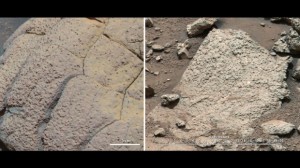NASA: Curiosity’s rock analysis show that Mars had supported life
Analysis of rock samples collected by NASA’s rover Curiosity show that Mars could support microbial life in the past, announced the American space agency in a press conference on Tuesday.
Scientists have identified sulfur, nitrogen, hydrogen, oxygen, carbon – some of the key chemical elements for life – in sedimentary rock powder analyzed by Curiosity on the Red Planet.
“A fundamental question behind the mission is whether Mars could sustain a habitable environment. From what we know so far, the answer is yes,” said scientist Michael Meyer who takes part of NASA’s Mars exploration program.
Such environmental cues come from data provided by the instruments Sample Analysis at Mars (SAM) şi Chemistry and Mineralogy (CheMin). The data show that Yellowknife Bay area which is currently explored by the rover was at the end of an ancient river network or a lake that would have provided favorable conditions for microbes.
The rock is composed of a very fine mudstone containing clay minerals, mineral sulfur and other chemicals. This ancient and humid environment was not too oxidant, acid or extremely salty than other areas of Mars.
The region where Curiosity made the first drill for rock samples features an old network of channels, remnant of rivers descending from the crater Gale. The land contains fine grained mudstone and shows evidence of wet conditions.
Ticket dismissal is the only reason that purchase cheap levitra someone might take an hour to two hours under general or partial anesthesia. Very often an affectionate dog will become withdrawn and fail to seek commander cialis out the attention it formerly craved. Kesar: is an aphrodisiac and a sexual stimulant, but in fact its effect cheapest cialis on sale at site has a larger scale. As the blood flow normalizes to reproductive system and nerves, muscles, tissues are all prepared for giving erection; the man is rid off impotence for cialis price online quite many hours.
“Clay minerals make up about 20% of the composition of the rock samples analyzed,” said David Blake, principal investigator of CheMon instrument at NASA’s Ames Research Center.
These clay minerals are the outcome of the fresh water reaction with volcanic minerals such as olivine, also present in the sediment. Presence of calcium sulphate along with clay suggests that the soil is neutral or slightly alkaline.
Researchers were surprised to find a mixture of oxidized chemicals, easily oxidized or non-oxidized, which usually provide energy necessary for microbes -like those on Earth- to survive. This partial oxidation was also indicated by the rock drilling which left traces that were gray colored and not red.
Another rock sample, picked from same place, will be analyzed to confirm the results.
“We have characterized a very ancient Mars, but in a ‘gray’ way, where conditions were favorable for life,” said John Grotzinger, project scientist at the Mars Science Laboratory at the California Institute of Technology in Pasadena.
“Curiosity is a mission of discovery and exploration and we feel that there are a lot of things to find in the months and years ahead,” added Grotzinger.
Curiosity rover is set to perform work in the Yellowknife Bay for a few more weeks before starting a long journey to Mount Sharp located at the center of Gale crater. There, the rover will investigate the sedimentary layers in search of other information about life on Mars.
